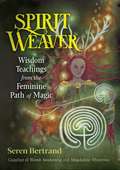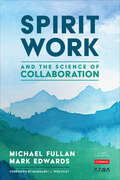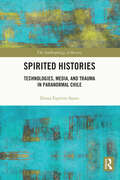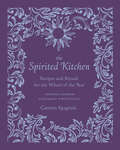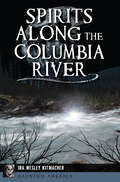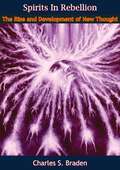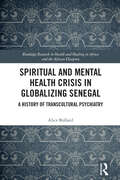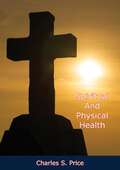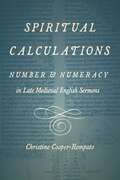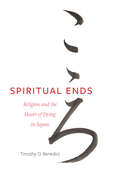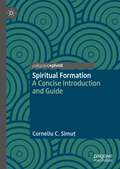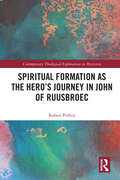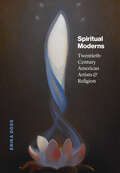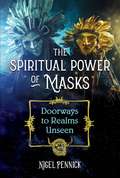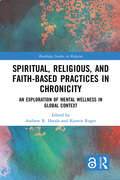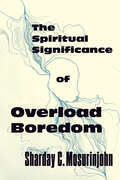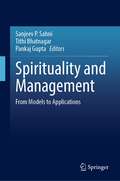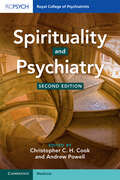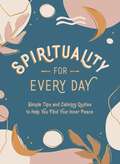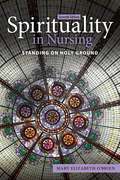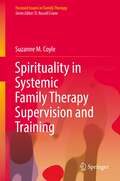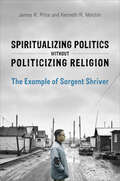- Table View
- List View
Spirit Weaver: Wisdom Teachings from the Feminine Path of Magic
by Seren Bertrand• Explains how to awaken your spiritual Womb to find strength within and how to reclaim your softness and vulnerability as a feminine superpower • Explores Earth Magic, the Moon Mysteries, Flower of Life teachings, Dragon wisdom, the shamanic powers of grief, the feminine archetypes of the Witch and the Priestess, and powerful goddesses from around the world • Reveals sacred spaces in the world where the power of the Goddess lives on The Womb is the seat of our primal power and intuition--our &“wild knowing.&” Spirit weavers are those who have heard this wild voice from within and have followed that call--embarking on a grail quest to follow the feminine path of magic, awaken to the depths of their soul, and embody their true feminine essence.Inviting you onto the spiral path of the spirit weaver, Seren Bertrand shares wisdom teachings and rituals from the feminine path of magic and her own ancestral lineage of old European witches and faerie folk, spirit keepers and story weavers. She explores Flower of Life teachings, the moon mysteries, and dragon wisdom. She unveils the shamanic powers of grief and deeply examines the feminine archetypes of the witch and the priestess. Drawing on powerful feminine spiritual icons from around the world, such as Kali, Isis, Teresa of Ávila, and Mary Magdalene, she explains how to awaken your spiritual Womb to find strength within and how to reclaim your soft powers of heart-opening vulnerability. She explores the lost traditions of the Goddess lineage and reveals sacred spaces in the world where her memory lives on. She shares the Womb Mysteries of alchemical union, revealing how to awaken the wild feminine and wild masculine and become sacred lovers who balance their light and shadow. From working with the cycles of the moon and learning how to root your power into the earth to healing the ancestral wounds left by the generations before you, Seren&’s medicine teachings, like secret spells, cast an enchantment over your feminine soul, awakening its fertility and wild inner magic.
Spirit Work and the Science of Collaboration
by Michael Fullan Mark EdwardsSpirit is the essence of character—of what it means to be human. Finding hope in the power of collaboration underpinned by ‘spirit work’-- the care and love of students as learners-- Fullan & Edwards capture how some school districts are creating a deep learning environment for all. COVID-19, racial inequity, polarizing politics, mass misinformation, and myriad other challenges have made the future of education seem bleaker than ever. Spirit Work and the Science of Collaboration speaks directly to leaders′ hearts and advocates for the development of two qualities that will bring back hope for the future of education: "spirit work" and the science of collaboration. Spirit work centers love and care for students, staff, and communities as the impetus for creating a positive culture, while collaboration is the vehicle for manifesting that spirit work. Through powerful case studies and vignettes, the authors show how spirit and collaboration represent revolutionary potential for education. Readers will find A lifeline amid overwhelming conditions. Hope for themselves and the future of education Practical ideas for building cohesion throughout school communities We cannot allow our best advocates for children to be consumed by today’s challenges. Spirit work and collaboration can pave the way to a brighter future.
Spirit Work and the Science of Collaboration
by Michael Fullan Mark EdwardsSpirit is the essence of character—of what it means to be human. Finding hope in the power of collaboration underpinned by ‘spirit work’-- the care and love of students as learners-- Fullan & Edwards capture how some school districts are creating a deep learning environment for all. COVID-19, racial inequity, polarizing politics, mass misinformation, and myriad other challenges have made the future of education seem bleaker than ever. Spirit Work and the Science of Collaboration speaks directly to leaders′ hearts and advocates for the development of two qualities that will bring back hope for the future of education: "spirit work" and the science of collaboration. Spirit work centers love and care for students, staff, and communities as the impetus for creating a positive culture, while collaboration is the vehicle for manifesting that spirit work. Through powerful case studies and vignettes, the authors show how spirit and collaboration represent revolutionary potential for education. Readers will find A lifeline amid overwhelming conditions. Hope for themselves and the future of education Practical ideas for building cohesion throughout school communities We cannot allow our best advocates for children to be consumed by today’s challenges. Spirit work and collaboration can pave the way to a brighter future.
Spirited Histories: Technologies, Media, and Trauma in Paranormal Chile (The Anthropology of History)
by Diana Espírito SantoSpirited Histories combines ethnography with critical theory to provide a sophisticated exploration of the intersection of haunting and the paranormal with technology, media, and history. Retrieving the past in places of trauma and death can take on many facets. One of these is an attention to hauntings, ghosts, and absences that go with the collective experience of loss and disappearance. People memorialize the dead and their stories in myriad ways. But what about the untold stories, or the forgotten, unnamed? This book explores the ways groups of Chilean paranormal investigators and ghost tour operators produce alternate histories using paranormal machinery, rather than simply theatricalizing pain. It offers a look at technologies, machines, and apparatuses – themselves imbued with a long history of supernatural and scientific expectations – and a social analysis of how certain groups of people marshal the voices of the dead to generate particular micro-histories. This fascinating volume will be of interest to a range of disciplines, including anthropology, sociology, history, religious studies, and scholars of technology and new media.
The Spirited Kitchen: Recipes And Rituals For The Wheel Of The Year
by Carmen SpagnolaWeave magic into every day with seasonal cooking and craft designed for each solstice, equinox, and halfway point in between! In The Spirited Kitchen, practicing witchcraft means nurturing a relationship with the seasons and drawing on ancestral roots to find magic in small details. From the Halloween festivities of Samhain to Midsummer celebrations and the return autumn at Harvest Home, witch and animist Carmen Spagnola will be your guide through the modern pagan Wheel of the Year. Here, you’ll learn to channel folk magic into every ingredient, feast, and centerpiece. In winter, Cranberry Custard Tarts encourage health and well-being; in spring, Deep Dish Nettle Quiche ushers in resilience after cold months; and Calendula Chicken embodies the abundance of summer. Along the way, ritual crafts like Salt Spells, Witches Ladders, and Corn Dollies set the scene with extra symbolism. Complete with stunning photographs, tips on foraging, and a glossary of spirited symbols and ingredients, this book is an enchanting guide to seasonal magic.
Spirits Along the Columbia River (Haunted America)
by Ira Wesley KitmacherThe breathtaking scenery of the Pacific Northwest hides a myriad of dark secrets.From sightings of the Columbia River Sea Serpent, nicknamed "Colossal Claude," to tales of Bigfoot encounters dating back to 1865, strange creatures lurk both on land and at sea. Shipwrecks, drownings, shanghaiing, and nautical superstitions abound. The restless settler spirits of those who lived and died on the Oregon Trail are said to linger alongside apparitions of adventurers and soldiers, while others, including the 1920's-era ghost of a woman in white and a man in top hat haunt places like the Columbia Gorge Hotel.Join author Ira Wesley Kitmacher as he takes you on a journey through one of the most haunted regions in America.
Spirits In Rebellion: The Rise and Development of New Thought
by Charles S. BradenThis 1963 book provides an invaluable glimpse into the mid-nineteenth century origins, beginning with Phineas P. Quimby, of the New Thought movement in the United States. It describes the careers of the most influential teachers and writers in the various schools and movements, with the exception of the well-known Christian Science church. Braden's text is a MUST for any serious student of metaphysics. The work delves deeply into the roots of New Thought and chronicles many key churches and movements throughout the United States and abroad. Braden writes with scholarly insight and spirit-led intuition.-Print ed.Charles Samuel Braden (19 September 1887 – 1970) was Professor and Chair of the Department of History and Literature of Religions at Northwestern University. He joined the faculty in 1926 and held the professorship from 1943; he was awarded emeritus status in 1954. Braden became known in particular for the study of new religious movements (NRM). His Spirits in Rebellion: The Rise and Development of New Thought (1963) remains the standard history of the New Thought family of NRMs.-Wiki
Spiritual and Mental Health Crisis in Globalizing Senegal: A History of Transcultural Psychiatry (Routledge Research in Health and Healing in Africa and the African Diaspora)
by Alice BullardThis book explores the history of mental health in Senegal, and how psychological difficulties were also expressed in the terms of spiritualism, magic, witchcraft, spirit possession and ancestor worship. Focused on the effervescent and fruitful early post-colonial years at the Fann Hospital, situated at the famed University of Dakar, Cheikh Anta Diop, this book reveals provocative treatment innovations via case studies of individuals struggling for health and healing. This book operates as a suspension bridge between scholarship on witchcraft and magic on the one side and the history of psychiatry and psycho-analysis on the other. This book creates a new route of exchange for healing knowledge for a broad array of West African spiritual troubles, mental illness, magic, soul cannibalism, witchcraft, spirit possession, and psychosis.
Spiritual And Physical Health
by Charles S. PriceA classic exposition by early 20th century Christian evangelist and divine healing practitioner Charles S. Price on the topic of spiritual and physical health.
Spiritual Calculations: Number and Numeracy in Late Medieval English Sermons
by Christine Cooper-RompatoMedieval English sermons teem with examples of quantitative reasoning, ranging from the arithmetical to the numerological, and regularly engage with numerical concepts. Examining sermons written in Middle English and Latin, this book reveals that popular English-speaking audiences were encouraged to engage in a wide range of numerate operations in their daily religious practices.Medieval sermonists promoted numeracy as a way for audiences to appreciate divine truth. Their sermons educated audiences in a hybrid form of numerate practice—one that relied on individuals’ pragmatic quantitative reasoning, which, when combined with spiritual interpretations of numbers provided by the preacher, created a deep and rich sense in which number was the best way to approach the sacred mysteries of the world as well as to learn how one could best live as a Christian. Analyzing both published and previously unpublished sermons and sermon cycles, Christine Cooper-Rompato explores the use of numbers, arithmetic, and other mathematical operations to better understand how medieval laypeople used math as a means to connect with God.Spiritual Calculations enhances our understanding of medieval sermons and sheds new light on how receptive audiences were to this sophisticated rhetorical form. It will be welcomed by scholars of Middle English literature, medieval sermon studies, religious experience, and the history of mathematics.
Spiritual Ends: Religion and the Heart of Dying in Japan (New Interventions in Japanese Studies #4)
by Timothy O. BenedictA free open access ebook is available upon publication. Learn more at www.luminosoa.org. What role does religion play at the end of life in Japan? Spiritual Ends draws on ethnographic fieldwork and interviews with hospice patients, chaplains, and medical workers to provide an intimate portrayal of how spiritual care is provided to the dying in Japan. Timothy O. Benedict uses both local and cross-cultural perspectives to show how hospice caregivers in Japan are appropriating and reinterpreting global ideas about spirituality and the practice of spiritual care. Benedict relates these findings to a longer story of how Japanese religious groups have pursued vocational roles in medical institutions as a means to demonstrate a so-called "healthy" role in society. By paying attention to how care for the kokoro (heart or mind) is key to the practice of spiritual care, this book enriches conventional understandings of religious identity in Japan while offering a valuable East Asian perspective to global conversations on the ways religion, spirituality, and medicine intersect at death.
Spiritual Formation: A Concise Introduction and Guide
by Corneliu C. SimuțThis book is a multichapter introduction to spiritual formation within the Christian tradition. Corneliu C. Simuț discusses spiritual formation from the views of several Christian thinkers, with a chapter devoted to each thinker. The concluding chapter notes common themes shared by each thinker. The author presents some key Patristic, Medieval, Early Modern, Modern, and Contemporary theologians in a way that is characterized by brevity, concision, and clarity. Thus, this small book is a useful introduction to spiritual formation from a Christian perspective. It would be helpful for a college student or young adult who seeks to be educated on the subject. The conciseness of the book is a benefit. Yet the book raises interesting questions for further pursuit. A very succinct – but comprehensive – historical presentation of sanctification through the lens of spiritual formation, a concept which has been revived in the past two decades, especially in Evangelical circles, this text is useful for a college course in spiritual formation or religion.
Spiritual Formation as the Hero’s Journey in John of Ruusbroec (Contemporary Theological Explorations in Mysticism)
by Robert PelfreyThis book examines the theology of spiritual formation developed by fourteenth-century Flemish mystic John of Ruusbroec, arguing that his formational path clearly and consistently displays the characteristics of the archetypal narrative structure of the hero’s journey. To start with a hermeneutical dialogue between scholars of the hero’s journey and Ruusbroec is established, employing the work of Hans-Georg Gadamer. The author then examines the stages and tropes of the hero’s journey according to Vladimir Propp, Joseph Campbell, Northrop Frye, René Girard, Dean Miller, and others, exploring the parallels in Ruusbroec’s writing and theology of spiritual formation. The book follows Ruusbroec’s story of answering the divine call, journeying inward and experiencing the trials of spiritual transformation, attaining the treasure of divine union, and returning in loving service to others. Finally, the ramifications of the argument for the interpretation and application of other mystical and heroic narratives are considered. Offering a new perspective on John of Ruusbroec, mystical theology, and the hero’s journey as spiritual quest, this volume will be of interest to scholars of mysticism, theology, formative spirituality, narrative theory, and religious literature of the Low Countries.
Spiritual Moderns: Twentieth-Century American Artists and Religion
by Erika DossExamines how and why religion matters in the history of modern American art. Andy Warhol is one of the best-known American artists of the twentieth century. He was also an observant Catholic who carried a rosary, went to mass regularly, kept a Bible by his bedside, and depicted religious subjects throughout his career. Warhol was a spiritual modern: a modern artist who appropriated religious images, beliefs, and practices to create a distinctive style of American art. Spiritual Moderns centers on four American artists who were both modern and religious. Joseph Cornell, who showed with the Surrealists, was a member of the Church of Christ, Scientist. Mark Tobey created pioneering works of Abstract Expressionism and was a follower of the Bahá’í Faith. Agnes Pelton was a Symbolist painter who embraced metaphysical movements including New Thought, Theosophy, and Agni Yoga. And Warhol, a leading figure in Pop art, was a lifelong Catholic. Working with biographical materials, social history, affect theory, and the tools of art history, Doss traces the linked subjects of art and religion and proposes a revised interpretation of American modernism.
Spiritual Moderns: Twentieth-Century American Artists and Religion
by Erika DossExamines how and why religion matters in the history of modern American art. Andy Warhol is one of the best-known American artists of the twentieth century. He was also an observant Catholic who carried a rosary, went to mass regularly, kept a Bible by his bedside, and depicted religious subjects throughout his career. Warhol was a spiritual modern: a modern artist who appropriated religious images, beliefs, and practices to create a distinctive style of American art. Spiritual Moderns centers on four American artists who were both modern and religious. Joseph Cornell, who showed with the Surrealists, was a member of the Church of Christ, Scientist. Mark Tobey created pioneering works of Abstract Expressionism and was a follower of the Bahá’í Faith. Agnes Pelton was a Symbolist painter who embraced metaphysical movements including New Thought, Theosophy, and Agni Yoga. And Warhol, a leading figure in Pop art, was a lifelong Catholic. Working with biographical materials, social history, affect theory, and the tools of art history, Doss traces the linked subjects of art and religion and proposes a revised interpretation of American modernism.
The Spiritual Power of Masks: Doorways to Realms Unseen
by Nigel Pennick• Reveals how mask rituals are akin to shamanic journeying and allow the mask wearer to personify an ancestral presence, spirit, deity, or power • Examines animal guising and shows how mask customs are tied to creation myths and the ancestral founders of a people, tribe, city, or nation • Looks at morris dancers and mummers in the UK, Krampuslauf and Perchtenlauf in Germanic areas, the Gorgon myths of Greece, Norse Berserker rituals, and the annual Black Forest rite to awaken ensouled masks every spring There is a spiritual power in masks that transports one into realms unseen and gives voice to things unspoken. Within the context of ritual, putting on a mask places the wearer at the intersection between the present and the past, the living and the dead, this world and the Otherworld. Masks make it possible to activate ancient archetypes, with the mask wearer reanimating or personifying an ancestral presence or spirit, a deity or power, an animal or a being of the eldritch world. In this illustrated study, Nigel Pennick explores the magical and spiritual aspects of mask wearing from ancient times to the present. He examines the many mask traditions around Europe and shows how mask rituals are similar to shamanic journeying and near-death experiences and can induce ecstatic states that allow the power signified by the mask to take possession of the individual wearing it. He also looks at the practice of dressing up as sacred animals and mask wearing as it relates to ostenta, events that occur suddenly and without warning that are considered a token or sign from the Otherworld. Unveiling the sacred power of masks, the author shows how masks allow us to transport into realms unseen, embody ancestors and otherworldly entities, and connect with traditions that stretch back to time immemorial.
Spiritual, Religious, and Faith-Based Practices in Chronicity: An Exploration of Mental Wellness in Global Context (Routledge Studies in Religion)
by Andrew R. HatalaThis book explores how people draw upon spiritual, religious, or faith-based practices to support their mental wellness amidst forms of chronicity. From diverse global contexts and spiritual perspectives, this volume critically examines several chronic conditions, such as psychosis, diabetes, depression, oppressive forces of colonization and social marginalization, attacks of spirit possession, or other forms of persistent mental duress. As an inter- and transdisciplinary collection, the chapters include innovative ethnographic observations and over 300 in-depth interviews with care providers and individuals living in chronicity, analyzed primarily from the phenomenological and hermeneutic meaning-making traditions. Overall, this book depicts a modern global era in which spiritualty and religion maintain an important role in many peoples’ lives, underscoring a need for increased awareness, intersectoral collaboration, and practical training for varied care providers. This book will be of interest to scholars of religion and health, the sociology and psychology of religion, medical and psychological anthropology, religious studies, and global health studies, as well as applied health and mental health professionals in psychology, social work, physical and occupational therapy, cultural psychiatry, public health, and medicine.
The Spiritual Significance of Overload Boredom
by Sharday C. MosurinjohnThe spiritual crisis of the twenty-first century is overload boredom. There is more information, content, and stimulation than ever before, and none of it is waiting passively to be consumed. The demands exceed our capacities.The Spiritual Significance of Overload Boredom makes the case that withdrawal and resistance are not our only options: we can choose kēdia, an ethic of care. Rather than conceiving the world of information as external, Sharday Mosurinjohn turns to the sensational and emotional, focusing on the ways the digital age has radically reconfigured our interior lives. Using an innovative method of affective aesthetic speculation, Mosurinjohn engages the world of art, literature, and comedy for a series of unexpected case studies that make strange otherwise familiar scenes of overload boredom: texting, browsing social media, and performing information work. Ultimately, she shows that the opposite of boredom is not interest but meaning, and that we can only make it by curating the overload.The Spiritual Significance of Overload Boredom is a bold and original intervention for the present condition, unsettling the framing of existing work around technological modernity and its discontents.
Spirituality and Management: From Models to Applications
by Pankaj Gupta Sanjeev P. Sahni Tithi BhatnagarThis book discusses the importance of integrating spirituality from diverse knowledge backgrounds to be effective in its everyday use. Bringing together global experts in the field, this book provides an extensive overview of the various spirituality and management themes, models, approaches, and complexities. The chapters in the book include deliberations upon wisdom from the Bhagwat Gita; Buddha; the impact of spirituality on good governance, quality of life; integrating ethics, human values, happiness; meditation; and linking of spirituality and management and their effect on leadership, and workplace environment. A thought-provoking read for scholars, students, and policy-makers, this book provides an Indian perspective on managing spirituality at work. This book is even more relevant in the post-COVID-19 scenario as it focuses on the holistic development of people and organizations.
Spirituality and Psychiatry
by Cook, Christopher C. H. Andrew PowellSpirituality and Psychiatry addresses the crucial but often overlooked relevance of spirituality to mental well-being and psychiatric care. This updated and expanded second edition explores the nature of spirituality, its relationship to religion, and the reasons for its importance in clinical practice. Contributors discuss the prevention and management of illness, and the maintenance of recovery. Different chapters focus on the subspecialties of psychiatry, including psychotherapy, child and adolescent psychiatry, intellectual disability, forensic psychiatry, substance misuse, and old age psychiatry. The book provides a critical review of the literature and a response to the questions posed by researchers, service users and clinicians, concerning the importance of spirituality in mental healthcare. With contributions from psychiatrists, psychologists, psychotherapists, nurses, mental healthcare chaplains and neuroscientists, and a patient perspective, this book is an invaluable clinical handbook for anyone interested in the place of spirituality in psychiatric practice.
Spirituality for Every Day: Simple Tips and Calming Quotes to Help You Find Your Inner Peace
by Summersdale PublishersEmbrace your spiritual side with this little book of tips and quotes that will help you on your journey to a more positive and peaceful life.For many, spirituality is a difficult concept to grasp. But the good news is anyone can understand and cultivate it. Whether you are new to spirituality or need some extra inspiration, you’ll find everything you need to get started in this book.Within these pages you will discover what spirituality is and how it can enhance your life, including:Meditation for mindful livingSensory activities for a deeper connection with naturePractising gratitude for a happier mindsetDaily positive mantras for better self-acceptanceFrom discovering your inner zen to learning how to chant, the tips, techniques and philosophies in this book will help you find serenity and look at the world with a new sense of wonder.Open your heart… feel at peace… and let this little guide show you how to find calm and tranquillity.
Spirituality for Every Day: Simple Tips and Calming Quotes to Help You Find Your Inner Peace
by Summersdale PublishersEmbrace your spiritual side with this little book of tips and quotes that will help you on your journey to a more positive and peaceful life.For many, spirituality is a difficult concept to grasp. But the good news is anyone can understand and cultivate it. Whether you are new to spirituality or need some extra inspiration, you’ll find everything you need to get started in this book.Within these pages you will discover what spirituality is and how it can enhance your life, including:Meditation for mindful livingSensory activities for a deeper connection with naturePractising gratitude for a happier mindsetDaily positive mantras for better self-acceptanceFrom discovering your inner zen to learning how to chant, the tips, techniques and philosophies in this book will help you find serenity and look at the world with a new sense of wonder.Open your heart… feel at peace… and let this little guide show you how to find calm and tranquillity.
Spirituality in Nursing: Standing on Holy Ground
by Mary-Elizabeth O'BrienThis book addresses the relationship between spirituality and nursing practice across a variety of settings related to caring for the ill and the infirm. The text covers the spiritual needs of special populations including children, families, and older adults, and takes on several significant issues in our society such as addiction, domestic terrorism, and the COVID-19 pandemic. The Seventh Edition examines both historical and contemporary issues pertaining to the spiritual needs and care of the sick. The text includes topical discussions of areas such as the nurse's role in spiritual care, the nurse-patient relationship, spiritual needs of special populations, and spiritual needs in areas such as mass casualty disasters and parish leadership. New content and references have been added to each chapter to reflect the most current ideas on spirituality in nursing.
Spirituality in Systemic Family Therapy Supervision and Training (Focused Issues in Family Therapy)
by Suzanne M. CoyleThis book examines the implications of exploring spirituality through the lens of human relationships. It addresses systemic supervision and training and explores a systemic approach to the development of the self. The book provides an educational methodology that lays a foundation in describing an operational model of spirituality that is applicable for both theistic and nontheistic perspectives. In addition, it details how spirituality is itself a diversity as well as explores spirituality through a lens of diversity. In addition, a pilot research project on spirituality set in a MFT Live Supervision Group illustrates how to apply a systemic approach to spirituality. Finally, the book offers examples of practice using spirituality in various training settings.Key areas of coverage include:· How a systemic approach to spirituality enables the lens of relationship and diversity to enrich supervising and teaching family therapy emerging from the self of therapist concerns.· Theoretical perspectives that connect systemic practice with spirituality in an approach for family therapy.· How a systemic spiritual approach can be used in training marriage and family therapists.· Interventions that focus on how a relational systemic approach views transcendence and immanence from both clinical and spiritual perspectives.· Concepts that inform supervision and training with the goals of educating students to be spiritually literate and spiritually sensitive.· Barriers to implementing this approach with examples of how to address such obstacles.Spirituality in Systemic Family Therapy Supervision and Training is a must-have resource for researchers, professors, graduate students as well as clinicians, supervisors, and professionals in clinical psychology, family studies / family therapy, and public health as well as all interrelated disciplines.
Spiritualizing Politics without Politicizing Religion: The Example of Sargent Shriver
by Kenneth R. Melchin James R. PriceThe clash of religion and politics has been a steady source of polarization in North America. In order to think wisely and constructively about the spiritual dimension of our political life, there is need for an approach that can both maintain the diversity of belief and foster values founded on the principles of religion. In Spiritualizing Politics without Politicizing Religion, James R. Price and Kenneth R. Melchin provide a possible framework, approaching issues in politics via a profile of Sargent Shriver (1915-2011), an American diplomat, politician, and a driving force behind the creation of the Peace Corps. Focusing on the speeches Shriver delivered in the course of his work to advance civil rights and build world peace, Price and Melchin highlight the spiritual component of his efforts to improve institutional structures and solve social problems. They contextualize Shriver’s approach by contrasting it with contemporary, landmark decisions of the U.S Supreme Court on the role of religion in politics. In doing so, Spiritualizing Politics without Politicizing Religion explains that navigating the relationship of religion and politics requires attending to both the religious diversity that politics must guard and the religious involvements that politics needs to do its work.
